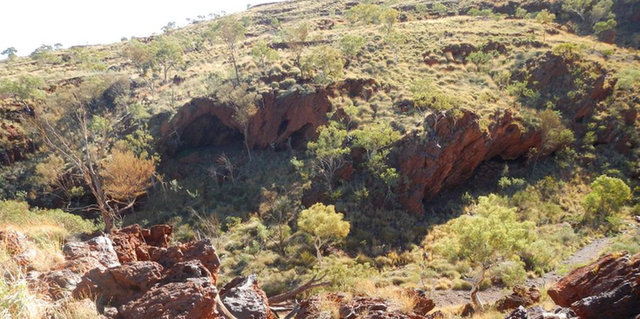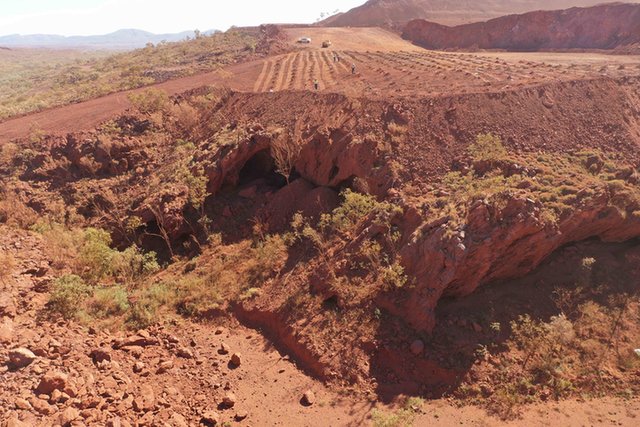Grinding stones, a bone sharpened into a tool, and 4,000-year-old braided hair were among the near 7,000 relics that had been discovered at the Aboriginal heritage site in Juukan Gorge, which was blown up by dynamite as part of Rio Tinto’s expansion process in Pilbara.
The ancient relics had genetic links to the present-day traditional owners, the Puutu Kunti Kurrama and Pinikura (PKKP) peoples. A PKKP representative, John Ashburton, told Reuters that the destruction of the site was a “devastating blow”.
“Our people are deeply troubled and saddened by the destruction of these rock shelters and are grieving the loss of connection to our ancestors as well as our land,” Ashburton told the news agency.
In a statement on Sunday, Rio Tinto Iron Ore chief executive Chris Salisbury said: “We are sorry for the distress we have caused.” Salisbury pledged to work with the PKKP to learn from the incident. “As a matter of urgency, we are reviewing the plans of all other sites in the Juukan Gorge area.”
More than half of the country’s coal mines are managed by pro-Russian separatist militia.Credit: DmyTo/Shutterstock.
More than half of the country’s coal mines are managed by pro-Russian separatist militia.
Credit: DmyTo/Shutterstock.
In the eyes of the law
Rio Tinto received permission to conduct the blasts in 2013 under Section 18 of the WA Aboriginal Heritage Act, according to ABC. It is an offence under Section 17 of the Aboriginal Heritage Act 1972 to excavate, destroy, damage, conceal or in any way alter an Aboriginal site. Where a landowner may breach Section 17 with respect to any Aboriginal sites on the land, they can apply for consent under Section 18 of the Act. Receiving consent has the effect of removing criminality from any breach of Section 17.
“Australia’s Minister for Indigenous Affairs Ken Wyatt said it was “incomprehensible” that the blast had been allowed to go ahead.”
After securing consent from the Minister for Aboriginal Affairs, the application system does not consider new information that comes to light, which caused frustration among the PKKP traditional owners.
According to the BBC, Australia’s Minister for Indigenous Affairs Ken Wyatt, himself Aboriginal, said it was “incomprehensible” that the blast had been allowed to go ahead. Rio Tinto, in its apology, pledged to advocate for legislative reform following the incident.

The Juukan Gorge prior to Rio Tinto’s expansion. Image: PKKP Corporation
“A string of vandalous destruction”
Anthropologist and geographer professor Marcia Langton AM, who has held the Foundation Chair of Australian Indigenous Studies at the University of Melbourne since 2000, told Mining Technology that an apology is not enough and that there is a strong case to be made that Rio Tinto breached the understanding of its agreement with traditional owners.
“Rio Tinto claims that it had the legal right to destroy these caves under Section 18 of the State’s Aboriginal Heritage Act,” Langton explained. “Long criticised for its role in a string of vandalous destruction of Aboriginal sacred sites and human occupation sites of great antiquity, the Act may be reviewed by the government in Perth.
“Other sites that have been desecrated and been destroyed include areas of the Burrup Peninsula, also in the Pilbara. These caves, along with several other places, held the evidence of the astonishing antiquity of human occupation of this continent. As such, as important as they were to the Aboriginal traditional owners, their significance for further understanding of deep human history is a matter that was wilfully ignored by Rio Tinto. Even a schoolchild with a modicum of historical knowledge understands this loss.”
“Even a schoolchild with a modicum of historical knowledge understands this loss.”
By blowing up the caves, Rio Tinto has also destroyed the last remaining evidence of the oldest site of human occupation on the continent, with some of the earliest artefacts showing animal bones fashioned into tools.
“For Aboriginal Australians the loss is heart-breaking, and moreover insulting that such a gross act of vandalism was timed to occur at the commencement of Reconciliation Week. This represents for Indigenous Australians a sharp turning point in relations with this company,” Langton continued.
ABC reported that under proposed changes to the Aboriginal Heritage Act, Section 18 notices will no longer exist.

The Juukan Gorge following Rio Tinto’s project. Image: PKKP Corporation
#AboriginalLivesMatter
The blast has drawn particular attention from social media users, with Rio Tinto issuing its apology during Reconciliation Week, which promotes learning about Australians’ shared histories, cultures and achievements.
Following the Black Lives Matter protests in the US, Australia also saw several protests in solidarity with the Black Lives Matter movement, and in shared opposition to racism. Resurgent themes of institutional racism and white supremacy led to discussions of Australia’s treatment of its Aboriginal peoples, with #AboriginalLivesMatter trending on Twitter in the country.
Australian Prime Minister Scott Morrison faces pressure to condemn Rio Tinto’s actions, notably from former Prime Minister Kevin Rudd, who tweeted: “After more than a week, why hasn’t Morrison condemned this? Rio Tinto’s corporate arrogance has robbed all Australians.”
“Rio Tinto’s corporate arrogance has robbed all Australians.”
Birkbeck, University of London archaeologist and anthropologist Dr Lawrence Owens told Mining Technology: “There is no other way of putting this – the destruction of Juukan Gorge cave was a travesty and a disgrace.
“It is difficult to fully express the magnitude of what this site was, what it meant, and how its destruction has impacted upon us all.
“I have seen some comparisons with Stonehenge and other important sites, and they are fair enough; we would be righteously angered if someone levelled Stonehenge in order to look for minerals. But I’m going to raise you a bit. This site isn’t 4,500 years old; it’s ten times as old as that. And it’s not just any site – it’s one of a handful that testifies to tens of thousands of years of occupation, changing landscapes, differing economies, climatic trends, wildlife changes…it was like an encyclopaedia of the Aboriginal people.”
The comparisons with other cultural heritage sites do not do full justice to what happened, Owens explained, because sites like Stonehenge do not have real links to people today – they are just relics of a bygone era. But the caves at Juukan Gorge are almost incomprehensibly older, with evidence of occupation dating back more than 40,000 years – or 2,000 generations of Aboriginal people.
“The miners pressed the button, but they aren’t to blame. If miners tried to mine under Stonehenge the government would – one would hope – have something to say about it. They wouldn’t have given them carte blanche to do whatever they wanted. But Australia’s government did. This is the same government that didn’t even recognise Aboriginals as people until 1971 when they were first included on the national census.”

AusProof is celebrating 25 years of business in Australia in 2019.

